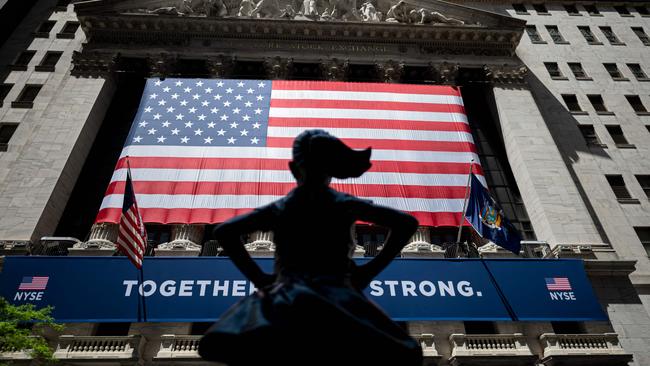Market may not have seen enough pullback yet strategists say
Strategists are questioning whether the share market has seen enough of a pullback to adjust for the higher rates outlook.

Strategists are questioning whether the sharemarket has seen enough of a pullback to adjust for the repricing of the interest rate outlook which hit bond markets in the US and Australia in recent weeks.
There’s also the risk of weaker earnings growth, as costs surged and profit margins began to peak in the December half-year, even before the impact of past rate hikes and rate hikes still to come.
After soaring 6.2 per cent in January, Australia’s S&P/ASX 200 index fell 2.9 per cent in February, having retreated 4.1 per cent from a more than nine-month its early February.
It was a similar story for the S&P 500. As of Monday, the US benchmark was down 2.3 per cent for the month, after falling 5.1 per cent from its early February peak. It rose 6.2 per cent in January.
The S&P 500 bounced off its 200-day moving average and was trying to hold its uptrend line, drawn from the October low. These would normally be good levels to “buy the dip.”
Australia’s S&P/ASX 200 tentatively respected an equivalent uptrend line this week.
BofA’s Global Fund Manager Survey is worth keeping in mind amid retail investor bullishness.
Funds were underweight equities and overweight cash. But there may be good reasons for this.
Recessions are nowhere to be seen, but that only reinforces the higher-for-longer rates outlook.
Moreover, the rates outlook has changed markedly since recent up trends in sharemarkets began in mid-October. Thankfully, China has stayed on its reopening path. But Western economic and inflation data have backed hawkish central bank rhetoric, and bond yields have soared.
Market-implied pricing for “terminal” central bank rates in the US, eurozone and Australia has risen to cycle highs and overall financial conditions probably aren’t as tight as they need to be.
After the higher than expected US core PCE data for January, another unexpectedly strong US non-farm payrolls report on March 11 and another strong US CPI report on March 14 could lead the Fed to re-accelerate the pace of Fed rate hikes to 50 basis points next month.
Australia’s RBA could again debate a potential 50 basis point hike next month. Disappointing wages growth lessened the pressure for a bigger hike. But another 100 basis points of hikes is priced in.
Large institutional bets early this month on a 6 per cent Fed funds rate, combined with last Thursday’s massive institutional buying of very short-dated S&P 500 put options, highlight the potential for higher than normal volatility in both the money market and the share market.
Barrenjoey Chief Macro Strategist, Damien Boey, said the zero-days-to-expiry S&P 500 options buying is “stopping volatility manifesting in longer-dated option indicators like the VIX”, for now.
But “tightening policy combined with stretched asset valuations is a recipe for higher volatility” and “rapid factor bucket switching (in recent weeks) typically foreshadows higher market volatility.”
J.P. Morgan’s Head of Global Strategy, Marko Kolanovic, said the risk/reward trade-off for stocks “remains poor” and Investors should “fade” the bond-equity divergence that remains after bond yields jumped and stocks initially rose after the February FOMC meeting.
History implies that for the current level of real rates, the S&P 500 price-to-earnings multiple is 2.5 points overvalued, implying a potential 14 per cent fall from the current level of 18 times.
“Higher-for-longer rates create negative externalities, including demand destruction, lower margins, higher interest cost for levered assets, especially real estate and small caps with higher floating debt exposure, and asset writedowns and credit losses,” Dr Kolanovic said.
“Additionally, complacency has set in with respect to geopolitics, but we believe geopolitical, and energy market risks are likely to re-escalate in the near future, given risks of a new Russian offensive and recent tensions between the West and China.”
Resilient activity data “poses upside risk to terminal Fed funds” and prompted JPMs to add another 25 bps hike to its ECB rates call, though they expect the next Fed moves to be in 25 bps increments.
With US rates markets already pricing in a terminal rate at around 5.4 per cent, JPM has a bullish bias on bonds and favours 10s/30s curve “steepeners” to position for an eventual Fed pause.
Morgan Stanley chief equity strategist Mike Wilson said the equity market was “showing signs of exhaustion after the last Fed meeting, and the S&P 500 is at “critical technical support.”
“Given our view on earnings, March is a high risk month for the bear market to resume,” he said.
“On the positive side, the US dollar could allow equities to make one more stand.”
Mr Wilson added that a recent “flattening” of the fall in the next 12-month earnings per share consensus for the S&P 500 has “provided some investor optimism”, but this is typical of the pattern during bear markets, and earnings forecasts were likely to keep trending down.
“Given our view that the earnings recession is far from over, we think March is a high risk month for the next leg lower in stocks,” said Morgan Stanley’s Wilson.
“Ultimately, we think this rally is a bull trap but recognise if these levels can hold, the equity market may have one last stand before we fully price the earnings downside.”
“We think interest rates and the US dollar both need to fall for this stand to have a chance.”
“Conversely, if rates and the dollar move higher, the technical support should fail quickly.”






To join the conversation, please log in. Don't have an account? Register
Join the conversation, you are commenting as Logout